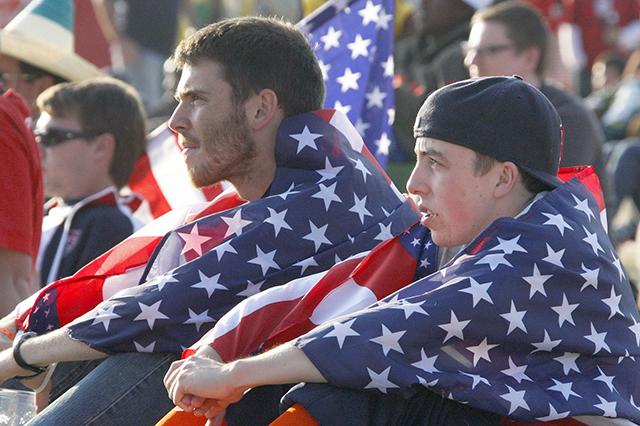The 2014 World Cup is done and dusted. As soccer fans worldwide begin another torturous four-year wait, it is time to reflect on soccer’s place in American sports culture.
Have booming television ratings, massive viewing parties and general “soccer mania” signaled the sport’s arrival in the United States? Not exactly.
Soccer has a long and rich American history for both players and fans. However, similar to the preference for the U.S. measurement system over the metric, our Americanized version of the sport makes the world’s game feel foreign to many viewers.
Some say soccer has arrived because USA vs. Portugal drew more than 25 million viewers.
Some say soccer has arrived because 30,000 fans showed up at Soldier Field in Chicago, a place which ironically held soccer matches decades before the Bears played a game there, to watch Team USA eventually get knocked out, 2-1, by Belgium on a Tuesday afternoon.
Soccer arrived a long time ago. Now, there are just more people on the wagon.
The total number of viewers in the U.S., which includes 16.5 million on ESPN plus Univision, watch parties and Internet streaming, exceeded the entire population of Belgium. So how did the U.S. lose?
Sporting success is largely tied to a country’s population size and wealth, according to the authors of “soccernomics,” Simon Kuper and Stefan Szymanski, who rank the U.S. among soccer’s four biggest underachievers.
Despite making it through the nicknamed “Group of Death,” another knockout stage exit is an absolute disappointment for a country with the size, wealth, and participation level of the U.S.
The U.S. men’s national team competed well. The team gave up a single goal to the eventual champion, Germany, drew with Cristiano Ronaldo and Portugal and defeated Ghana, but the thoughts that the U.S. has arrived as an international soccer power are grossly exaggerated.
The team’s effort and never-say-die attitude are commendable, but those attributes don’t win trophies. They are expectations—requirements of winning sides.
No one is praising the German team, which destroyed hosts Brazil, 7-1, for having “grit and heart.”
There is a misleading argument that because the United States’ biggest and best athletes don’t play soccer, we are incapable of matching sides like Germany or Argentina.
Mario Göetze, who scored the winning goal in the final, and Lionel Messi, the de facto world’s best player and winner of the Golden Ball as the tournament’s top player, are 5-foot-9 and 5-foot-7, respectively.
These players stand at the peak of world soccer because their backgrounds include a single-minded focus on technical and intellectual player development, which is something that the U.S. lacks.
At the youth level, an overt focus on winning, rather than developing players, typically means bigger, faster and stronger kids are preferred, while those with slower physical development but better ball skills can be overlooked.
Though soccer is a simple and inexpensive game, receiving a proper sporting education in the U.S. is nearly impossible without spending thousands of dollars.
The American version of Lionel Messi or Mario Göetze could be playing in a Los Angeles barrio dirt lot right now, but will never have his talent exposed because he cannot afford an $800 club fee.
The gap in development between the U.S. and other countries grows wider as players age, specifically in the collegiate level’s capacity to produce world-class players.
Though the NCAA is excellent for U.S.-dominated sports such as basketball and football, it is inefficient for producing soccer players capable of competing with the rest of the world.
If he were American, Göetze, 22, would be a senior in college, playing a competitive season from August to November.
Instead, the three-time Bundesliga champion and World Cup winner entered Borussia Dortmund’s youth academy as an 8-year-old and debuted professionally for Bayern Munich before his 18th birthday.
He and other young players in Europe compete year-round under the best coaches and against the best players.
Even in top collegiate programs, coaches struggle to overcome NCAA limitations: short seasons, limited time with players by rule and a focus on winning. These restrictions shift focus away from maximizing individual players for professional competition.
The good news is that the missteps can be corrected. Fourteen years ago, Germany finished in last place in its European Championship group.
In response, the country overhauled its approach to youth development and embarked on a decade-long quest to place the nation back into world soccer’s pinnacle.
The German federation enforced academy policies, created new guidelines and qualifications for youth coaches and invested heavily in grassroots soccer, borrowing techniques from the excellent Dutch youth system.
At the World Cup in 2010, a young German team barely missed out on the final, losing 1-0 to eventual champions, Spain, in the semifinals.
Four years later, the team lifted the trophy in Rio de Janeiro.
This was not a fluke, but a golden generation, or a once-in-a-lifetime gathering of talent. Germany’s World Cup win was the result of a decade of hard work and a unified approach in developing world-class players.
Germany built a sustainable system, the same system that the U.S. can build with commitment and patience.
Soccer arrived in the U.S. years ago, but thanks to the World Cup, attention to it has never been higher, and so the time is ripe for making meaningful change.
Jürgen Klinsmann, head coach of the U.S. men’s national soccer team, has started leading the way forward and suggesting those changes, a few of which have already been implemented.
The blueprint is laid out, and Germany has proven that it works, but everyone must buy in, from top to bottom.








